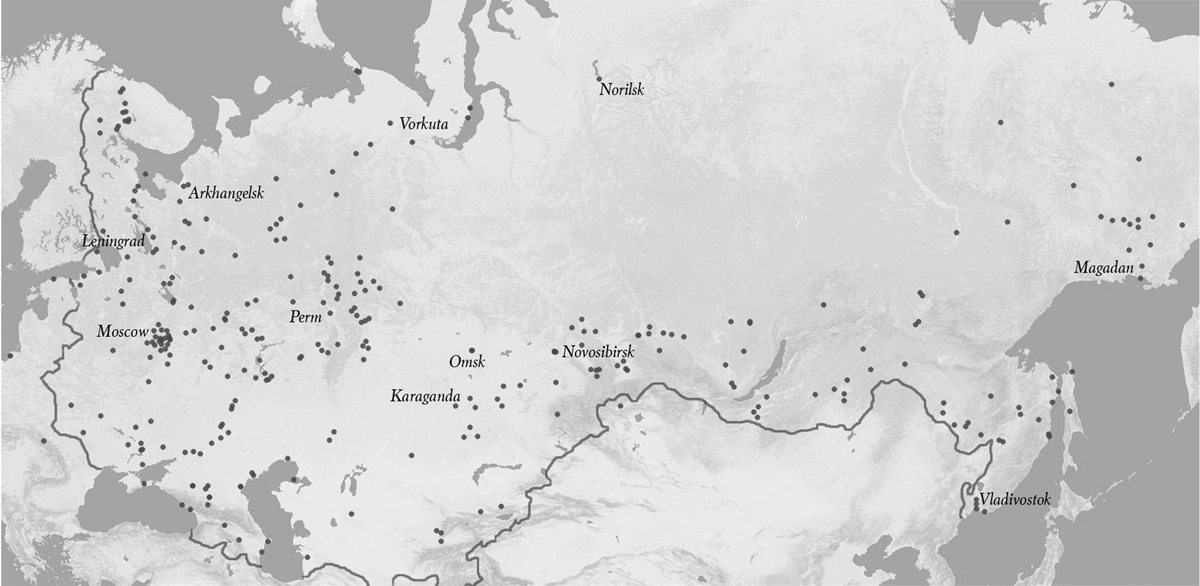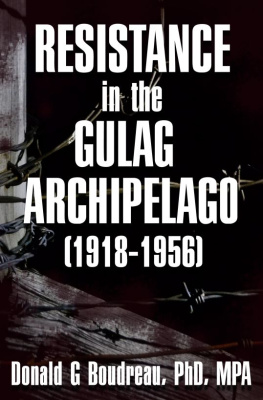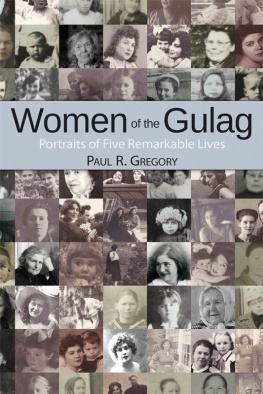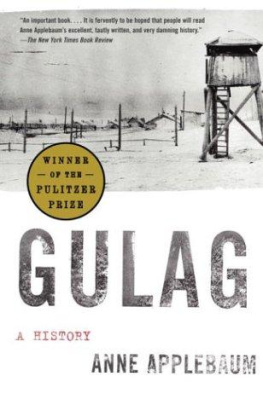THE YALE-HOOVER SERIES ON AUTHORITARIAN REGIMES
ILLNESS AND INHUMANITY IN STALINS GULAG
GOLFO ALEXOPOULOS
Hoover Institution
Stanford University
Stanford, California
Yale UNIVERSITY PRESS
New Haven and London
Published with assistance from the foundation established in memory of Philip Hamilton McMillan of the Class of 1894, Yale College.
Copyright 2017 by Yale University and the Board of Trustees of the Leland Stanford Jr. University.
All rights reserved.
This book may not be reproduced, in whole or in part, including illustrations, in any form (beyond that copying permitted by Sections 107 and 108 of the U.S. Copyright Law and except by reviewers for the public press), without written permission from the publishers.
Yale University Press books may be purchased in quantity for educational, business, or promotional use. For information, please e-mail (U.K. office).
Set in Sabon type by Newgen North America.
Printed in the United States of America.
Library of Congress Control Number: 2016951586
ISBN 978-0-300-17941-5 (hardcover : alk. paper)
A catalogue record for this book is available from the British Library.
This paper meets the requirements of ANSI/NISO Z39.481992 (Permanence of Paper).
10 9 8 7 6 5 4 3 2 1
To Thomas, Athena, and Sophia with love
Contents
Acknowledgments
Most of the archival research for this book took place in 20072008, when I was a W. Glenn Campbell and Rita Ricardo-Campbell National Fellow and the William C. Bark National Fellow at the Hoover Institution. During that memorable year in Palo Alto, I worked with the microfilm collection of Soviet state and party archives at the Hoover Institution Library and Archives, spending most of my time on Gulag records. The remarkable collection made this book possible. I would like to thank especially Paul Gregory for his support of the project, as well as Eric Wakin and the Hoover Institution Library and Archives directors. Over the years, I have benefited greatly from conversations with a brilliant group of scholars at the Hoover Institutions Workshop on Authoritarian Regimes, especially Mark Harrison, Oleg Khlevniuk, Mark Kramer, Anne Applebaum, Norman Naimark, and Amir Weiner, as well as Jrg Baberowski, Evgenia Belova, Leonid Borodkin, John Dunlop, Michael Ellman, Simon Ertz, Catherine Gousseff, James Heinzen, Emily Johnson, Katherine Jolluck, Deborah Kaple, Stephen Kotkin, Valery Lazarev, Andrei Markevich, David Sadder, Robert Service, and David Shearer. I am very grateful to Carol Leadenham, Lora Soroka, David Jacobs, and Linda Bernard of the Hoover Institution Library and Archives, who facilitated my research in innumerable ways. This book is very much a product of the Hoover Institutions exceptional resources, scholarly community, and generosity.
Many people have helped me with this project over the years. It gives me great pleasure to acknowledge them here, beginning with William Frucht, my editor at Yale University Press, for his support of the manuscript, as well as Karen Olson, Mary Pasti, and Jaya Chatterjee for their help at various stages of production. The external reviewers of my manuscript for the Press and my copyeditor, Beverly Michaels, made this book so much better. I also thank Nanci Adler, Patty Apostolos, Alan Barenberg, Steven Barnes, Jenna Bednar, Kees Boterbloem, Shawn Coyne, Michael David-Fox, Michael Decker, Chelsea Esposito, Marcie Finkelstein, Sheila Fitzpatrick, Klaus Gestwa, Jehanne Gheith, Maria Gough, Patricia Gorman, Jana Howlett, David Joravsky, Cheryl Kirstein, Diane Koenker, Judy Morachnik, Adriana Novoa, Victor Peppard, Judith Pallot, Darrell Slider, Peter Solomon, Sofia Somonova, Nikolai Ssorin-Chaikov, Vadim Staklo, Mariana Stavig, and Stephen Turner. I am very grateful to Irina Flige, Tatiana Morgacheva, Evgeniya Kulakova, Ira Suslova, and the archivists at Memorial in St. Petersburg for their generous assistance. I also wish to thank Sam Diener for his important editing and feedback, as well as Ronald Grigor Suny and Valerie Sperling for their encouragement, support, and invaluable insights. My former students at the University of South Florida, Lydia Greiner and Ivana Lam, provided excellent research assistance.
I am forever grateful to my family, whose love, support, and patience enabled me to complete this difficult project, especially George and Pola Alexopoulos, Lia Alexopoulos (whose help has been truly immeasurable), Greg and Kimberly Alexopoulos, and James and Cornelia Smith. This book is dedicated with deep love and gratitude to my husband, Thomas Wright Smith, and to our daughters, Athena Alexopoulos Smith and Sophia Panayiota Smith. I could not have done it without you.
My research and writing have been supported by the Hoover Institution, the National Endowment for the Humanities (NEH), the National Council for East European and Eurasian Research (NCEEER), and the College of Arts and Sciences at the University of South Florida. Parts of this book appeared in my article Destructive-Labor Camps: Rethinking Solzhenitsyns Play on Words, in Kritika: Explorations in Russian and Eurasian History 16:3 (Summer 2015): 499526, and are reprinted here with the journals permission.
A Note on Archives and Language
The archival documents cited in this book overwhelmingly derive from the microfilm collection of the Archives of the Soviet Communist Party and Soviet State at the Hoover Institution Library and Archives, Stanford University. The Hoover microfilm collection includes the archival records of the Gulag administration, which are located in the State Archive of the Russian Federation (Gosudarstvennyi Arkhiv Rossiiskoi Federatsii), herein abbreviated as GARF.
Quotations from the original Russian follow the Library of Congress transliteration system. However, consistent with accepted practice, I write Dalstroi instead of Dalstroi and Norillag instead of Norillag, and I use a y rather than ii at the end of Russian namesfor example, Primorsky instead of Primorskii. Unless otherwise indicated, all translations of Russian sources are my own.

Locations of forced labor camps and colonies during the Stalin years. This map provides only a rough overview, as Gulag sites shifted frequently. I thank Judith Pallot, Sofia Gavrilova, and the Economic and Social Research Council (ESRC) for providing the data and Chelsea Esposito for creating the map.
ILLNESS AND INHUMANITY IN STALINS GULAG
Introduction
Exploiting Human Raw Material
JOSEPH STALINS FORCED labor camp system constituted an enormous penal-industrial complex that lasted for nearly a quarter of a century in the Soviet Union. It has been less than two decades since the declassification of the Gulag archive, and new scholarship is only beginning to shed light on this dark corner of twentieth-century European history. Although Gulag survivors often spoke of these as death camps, historians initial archival findings revealed high-level concerns for labor productivity, condemnations of prisoner abuse, frequent prisoner releases, and low mortality rates. Thus the prevailing view among Gulag scholars has been that these were not camps where prisoners were destroyed by design. In the course of my own research, however, a very different picture emerged. My investigation into health and medicine in the Gulag, a largely neglected area of study, led me to a broad range of material on prisoners physical exploitation. What I discovered in the archives surprised me. Stalins Gulag constituted a highly coordinated and lethal system of human exploitation. Viewed as mere inputs in an industrial process, prisoners were supposed to be thoroughly exploited and totally depleted. To be sure, not all inmates faced certain death. Total extermination was not Stalins goal, but total exploitation was. The present work demonstrates that the Gulag represented a willfully destructive institution to a degree not previously documented, and that the Stalinist regime systematically concealed the Gulags destructive capacity.
Next page







